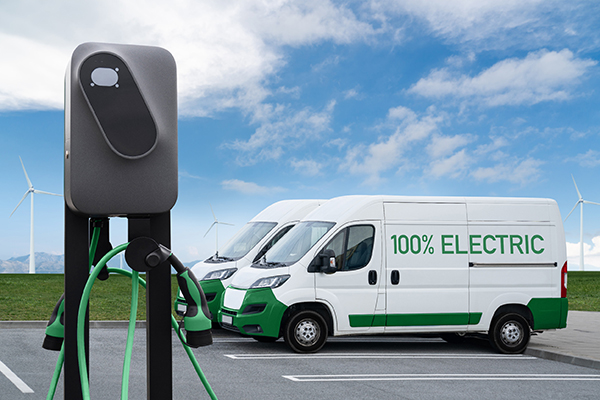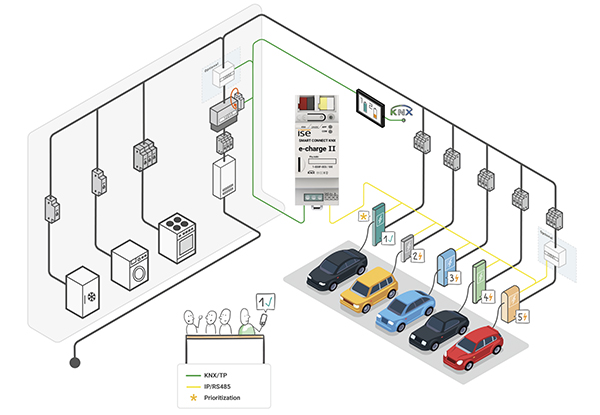
André Hänel discusses the challenges faced by larger electric vehicles when it comes to charging, and why it makes sense to integrate this facility in a wider KNX installation.
The use of battery electric vehicles (BEVs) is steadily increasing. In Germany for example, newly-licensed BEVs for the first half of the year in 2023 exceeded 220,000. Whilst most are being used as private vehicles, the number of transporters and trucks remains negligible due to overall operating range limitations, the required time to charge the vehicle and the availability of charging points on motorways. This applies especially to trucks. Besides issues of cost and availability, the lack of a comprehensive charging network combined with high-power charging requirements are limiting factors for longer-distance electric trucks.

Whilst a solution for larger trucks has yet to be developed, a potential candidate is KNX, as it is already proving itself in the domain of private vehicles and tradesperson vans. A comprehensive building control system implemented with KNX provides the possibility of embedding and managing electrical charging control. This includes the ability to manage several charging points at once, aligning the individual power requests per customer equally, or defining specific control logic/monitoring functionality.
Charging points
A charging point provides either DC (usually the fast-charging networks on motorways) or AC, but since the battery of a BEV can only be charged with DC, the AC must be converted to DC. For this, a BEV contains an integrated AC/DC converter that typically supports power ranges between 2.3 – 22kW in the case of private vehicles.
Limiting factors to consider include the fuse capacity of the property, or the capacity of the supplying medium voltage transformer (aka grid network level 6). In residential areas, a per-customer required maximum charging power (e.g. 11kW) could put a strain on the energy supply if individual charging periods from multiple customers overlap in time. This holds true especially if there is more than one charging point per building grid connection point, such as in a business environment with several charging points used by employees. Consequently, each (maximum) charging power request per employee must be aligned in accordance with the building’s currently available power and the likely time the employee will want to leave, whilst also considering a possible temporarily-reduced power availability that is instructed by the grid provider (aka power limitation).
Using KNX to manage the charging process
In terms of managing the charging process, KNX offers the following solutions:
1) Simple solutions connect the charging station via a specific (Modbus TCP/RTU) interface. Depending on the vendor of the charging point, all related protocol and data settings have to be configured by the installer. In this case, the actual control logic for the charging process must be performed by an external entity such as an energy management application as part of the KNX installation.

2) More professional solutions use interfaces with preconfigured charging station profiles from several vendors, each of which encapsulates all required configuration data. With such interfaces, the number of supported profiles and vendors is updated regularly, and a local control logic is also included to offload specific tasks from the overall energy management application.

Several options exist with different vendor products, where the interface logic is directly embedded as part of an energy management system or visualisation. In either of the above cases, the customer-intended functionality is configured by the KNX installer using ETS software. As is typical for the KNX system, each functionality of an installation is exposed with dedicated and standardised datapoints, provided by the devices. This also holds true for a BEV charging control setup, where available datapoints would be, for example, for the voltage, current or power.
Since all charging-relevant data is present in KNX at runtime, functionality that is peripheral to charging is also possible, such as access control for the charging points, power monitoring or accounting.
KNX-based energy management can also automate when the optimal time for charging is, taking into account varying energy tariffs, self-produced power and the demands/timings of other electricity-consuming devices in the home.
Summary
The benefits of including vehicle charging in a KNX installation are many. The most obvious is that it can be linked with a wide range of other KNX building control functions, so that many factors can be taken into account, resulting in a comprehensive building control and energy management system. In addition, the entire installation can be designed by the KNX installer using ETS, resulting in one overall system design, documentation, and customer support from one source.
Charging control is just one aspect of a wider KNX energy management strategy that involves closer integration of main electrical energy producers such as photovoltaic (inverters), electrical batteries or heat pumps. They can all use a common interface, and be controlled intelligently to optimise energy use and reduce our carbon footprint.
André Hänel is responsible for the System and Tools Department for the KNX Association.












